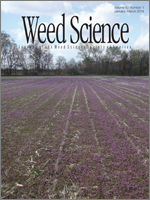Since its discovery in 2005, glyphosate-resistant Palmer amaranth has become a major problem for many farmers in the southern United States. One mechanism of resistance found in a Georgia population of glyphosate-resistant Palmer amaranth is amplification of the 5-enolpyruvylshikimate-3-phosphate synthase (EPSPS) gene throughout the genome, with some resistant plants containing and expressing more than 100 EPSPS genes. Such high numbers of EPSPS genes and protein production could result in a fitness cost to resistant plants due to (1) metabolic cost of overproduction of this enzyme and (2) disruption of other genes after insertion of the EPSPS gene. A greenhouse experiment was set up to investigate differences in growth and reproduction between glyphosate-susceptible and -resistant Palmer amaranth plants. Measurements included growth rate, plant height/volume ratio, final biomass, photosynthetic rate, inflorescence length, pollen viability, and seed set. This study found no significant fitness costs for plants with the resistance trait. This study also provided a clear example of how controlling for genetic background is important in fitness cost studies and how potentially misleading results can be obtained if only a few fitness traits are measured. These results indicate that glyphosate-resistant Palmer amaranth plants with high EPSPS gene copy numbers are likely to persist in field populations, even in the absence of glyphosate, potentially leading to long-term loss of glyphosate as a control option for Palmer amaranth.
Nomenclature: Glyphosate; Palmer amaranth, Amaranthus palmeri S. Wats AMAPA.





